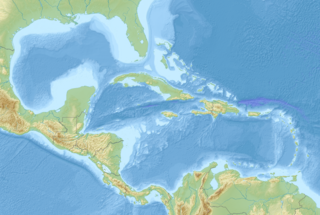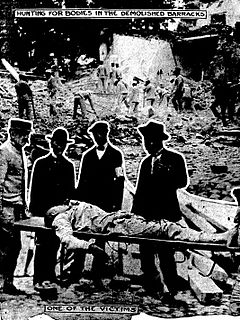
The 2006 Gulf of Mexico earthquake occurred in the eastern Gulf of Mexico on September 10 at . The intraplate earthquake measured 5.8 on the moment magnitude scale and its epicenter was located about 250 miles (400 km) west-southwest of Anna Maria, Florida. The event was felt throughout much of the Gulf Coast of the United States and was the second earthquake of magnitude 5 or greater in the Gulf during 2006. Felt intensities, as measured on the Mercalli intensity scale, were as high as IV (Light) in Florida, with parts of Georgia at III (Weak).

At 9:41:58 a.m. on March 25, 2007, a magnitude 6.9 earthquake struck the Hokuriku region of Japan, near the Noto Peninsula. The earthquake shook the city of Wajima, the city of Nanao, and the town of Anamizu with a seismic intensity of 6+ on Japan's shindo scale. One death, in the city of Wajima, and at least 356 injuries have been reported.

This list of 20th-century earthquakes is a global list of notable earthquakes that occurred in the 20th century. After 1900 most earthquakes have some degree of instrumental records and this means that the locations and magnitudes are more reliable than for earlier events. To prevent this list becoming unmanageable, only those of magnitude 6 and above are included unless they are notable for some other reason.

The 1995 Colima–Jalisco earthquake occurred on October 9 at 15:35 UTC with a moment magnitude of 8.0 and a maximum Mercalli intensity of VIII (Severe). The shock occurred off the coast of Jalisco, Mexico, where a tsunami was triggered that affected a 200 km (120 mi) stretch of the coast. The earthquake could be felt in Mexico City and in high-rise buildings in Dallas and Houston. In Mexico, the Cihuatlan-Manzanillo was the most severely affected area. At least 49 people died and 100 were injured.

The 1999 Oaxaca earthquake occurred on September 30 at 11:31 local time in Oaxaca, Mexico, 60 km NNW of Puerto Ángel. The epicenter was located near San Agustin Loxicha. It had a magnitude of 7.4. The maximum intensity reached MM VIII in southwestern Oaxaca, and could be felt strongly in Mexico City. The torrential rains preceding and following the temblor intensified the damage of this earthquake. Thirty-five people were reported dead. The archeological site of the ancient Zapotec city of Monte Alban also suffered damage in this earthquake. This was an intraplate earthquake in the Cocos Plate, with a normal-faulting mechanism. The fault plane was 90 km long and 45 km wide. The maximum slip was about 2.5 m, which was located about 20 and 40 km WNW of the hypocenter.

The 1999 Tehuacán earthquake, or the 1999 Central Mexico earthquake, occurred on June 15 at 15:42 local time near Tehuacán, Puebla, Mexico, close to the state of Oaxaca. The earthquake measured 7.0 on the moment magnitude scale.

The 1973 Veracruz earthquake, also known as El Terremoto de Orizaba, occurred at 3:50 a.m. local time on August 28, with the epicenter located in the vicinity of Serdán in the Mexican state of Puebla. It registered 7.0 on the Richter magnitude scale and had a maximum perceived intensity of VIII (Severe) on the Mercalli intensity scale. The effects of the earthquake were felt in the Mexican states of Veracruz and Puebla in southeast Mexico.

The 1941 Colima earthquake occurred on April 15 at 19:09 UTC. The epicenter was located in the State of Michoacán, Mexico.

The 1995 Guerrero earthquake occurred on September 14, 1995, at 14:04 UTC. This earthquake had a magnitude of 7.4, with the epicenter being located in the state of Guerrero, Mexico. Three people were reported dead. In the rural part of southeast Guerrero, many houses with adobe of poor quality suffered heavier damage. The intensity in Copala reached MM VII. The earthquake could be felt strongly along the coast from Michoacán to Chiapas.

The 1995 Chiapas earthquake occurred on . The epicenter was located in Ocozocoautla de Espinosa, in the state of Chiapas, Mexico, near Tuxtla Gutiérrez. It had a magnitude of 7.1, or 6.5. Building damage was reported. Around 70 people were reported injured. In Tuxtla Gutiérrez, telephone and electricity services were momentarily interrupted. This earthquake could be felt strongly in Mexico City and in many parts of southern Mexico. It could also be felt in Guatemala and El Salvador. The centroid mechanism is of thrust faulting with a small strike-slip component. The rupture of this earthquake propagated from NW to SE over a distance of about 30 km. The duration of the rupture was about 17 s. The earthquake was resulted from the internal deformation of the Cocos Plate, which is subducting beneath the North American Plate.

The 1911 Michoacán earthquake occurred on June 7 at 04:26 local time. The epicenter was located near the coast of Michoacán, Mexico. The earthquake had a magnitude of 7.6 on the moment magnitude scale. 45 people were reported dead. In Mexico City, 119 houses were destroyed. Cracks were reported in Palacio Nacional, Escuela Normal para Maestros, Escuela Preparatoria, Inspección de Policía, and Instituto Geológico. Ciudad Guzmán, the seat of Zapotlán el Grande, Jalisco, suffered great damage.

The 1911 Guerrero earthquake occurred on December 16 at near the coast of Guerrero, Mexico along the Mexican subduction zone. The earthquake's energy was calculated using several different magnitude scales with an estimated moment magnitude of 7.6 and a surface wave magnitude of 7.8. Following the event, telegraphy reports came in from a broad area of Mexico. Cities from Guadalajara, Mérida, and Tapachula all reported the tremors. The duration of the shaking was just over two minutes and the death toll was placed at 28.

The 1964 Guerrero earthquake occurred on July 6 at in Guerrero, Mexico. The magnitude of this earthquake was given as Ms 7.4, or ML 7.2.

The 1942 Guatemala earthquake occurred at on August 6 and had ratings of 7.7 on the moment magnitude scale and 7.9 on the surface wave magnitude scale. The epicenter was located off the southern coast of Guatemala, and it was one of the strongest earthquakes ever recorded there.

The 1942 Peru earthquake occurred on August 24 at and was located near the border of the departments of Ica and Arequipa, Peru. It had a magnitude of 8.2 or 8.4.

The 1920 Xalapa earthquake rocked the gulf coast of Mexico on January 4, causing major damage in the states of Veracruz and Puebla. The epicenter was located somewhere in mountainous region of the eastern Trans-Mexican Volcanic Belt which triggered massive mudflows and landslides which claimed anywhere between 700 to 4,000 lives. The event produced extreme ground motions reaching causing severe ground effects. The epicentral region of this earthquake was allocated the maximum level of shaking at XII (Extreme) on the Modified Mercalli intensity scale. It would remain the deadliest earthquake in Mexico until the 1985 Mexico City earthquake.







